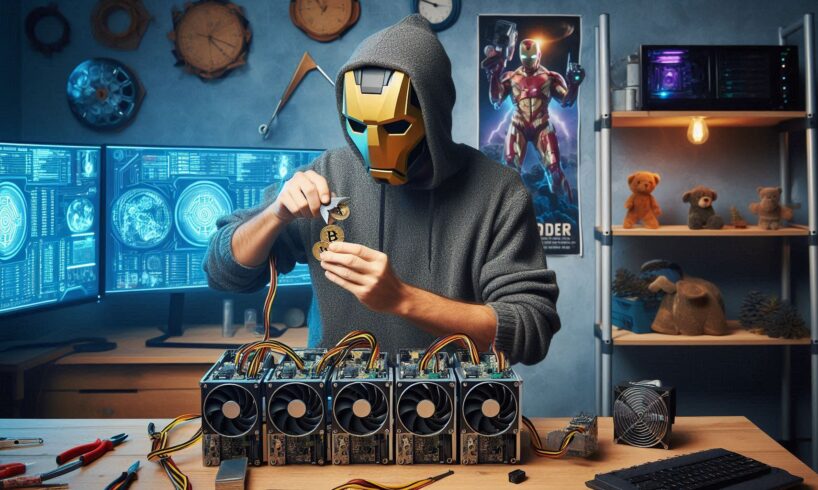
In reality, building a cryptocurrency mining rig has become something that the technology enthusiast and investor everywhere look to do in order to get some potential profit from this modern venture. However, behind all the hype are several honest concerns, since building a mining rig requires precise planning, substantial research, and reasonable investment. A mining rig is basically a computer designed to solve the cryptographic puzzles, helping validate transactions in the blockchain network, earning rewards in the form of cryptocurrency. In this article, we are going to explain step by step how a custom mining rig from scratch can be built.
First, let’s take a glance at the basics behind cryptocurrency mining.
Before going into the actual process of making a mining rig, we first need to understand what cryptocurrency mining is all about. Cryptocurrencies like Bitcoin and Ethereum and many others depend on decentralized systems known as blockchains. Transactions are added to the blockchain by solving very intricate mathematical problems-a process termed “proof of work.”.
Miners use bespoke equipment to solve these problems, and once they solve a problem, a transaction is confirmed, and the miner gets rewarded with cryptocurrency. Mining can be done on various blockchains and requires varying levels of computational power.
Also Read: How to Calculate Cryptocurrency Tax: A Step-by-Step Guide
Step 1: Selecting the Right Cryptocurrency for Me
First, you need to decide on what cryptocurrency you would like to mine. Different cryptocurrencies employ diverse mining algorithms and even some require much more powerful hardware. Mining the Bitcoin algorithm requires an enormous amount of computational power along with a high amount of energy consumption, thus heavily discouraged for new miners. Coins such as Ethereum which transition to proof-of-stake, or a smaller altcoin could be more accessible to a new miner.
You should look into the profit margins of the coins, how much electricity they consume, the cost to start with the hardware, and possibly how much they might be worth when you’re done.
You can use the tools on whattomine.com to anticipate potential profit margins based on your hardware and electricity costs.
Step 2: Selecting Your Hardware
In mining cryptocurrencies, you’ll need specialized hardware designed to work with heavy-duty mathematical computations. Here are some of the primary components for your mining rig:
-
Motherboard
The motherboard is the central connection hub where all the component parts of your mining rig connect. To be successful, you’ll need a motherboard that can accept multiple GPUs. Some good options include ASUS B250 Mining Expert or the MSI Z170A Gaming Pro, both of which support multi-GPU support.
-
Graphics Processing Units (GPUs)
The core of any mining rig is the GPU. How effectively the GPUs are performing has a lot to do with the computing of mathematical calculations for mining cryptocurrencies. The more the number of GPUs, the more the hashing power, the more rewards there are chances of getting. Some of the best GPUs for mining include Nvidia GeForce RTX 3080, AMD Radeon RX 580, and Nvidia GTX 1660 Super.
Important to mention here is that the GPUs are rather expensive, and sometimes it might not be easy to get one as most people demand them for use. Sometimes, you might need to go shopping around for the best prices or even second-hand GPUs.
-
Power Supply Unit (PSU)
Mining rigs consume so much power that you may require a sufficiently powerful PSU to carry the load. You, therefore, need to choose a PSU with enough wattage to power all your GPUs and other components. For example, if you are using six GPUs, at least a 1200W power supply is necessary. Seasonic and EVGA are two well-known brands used for mining rigs.
-
Processor (CPU)
While the real beef is done by GPUs, you will need a processor to make your rig work. Mining rigs do not require high-end CPUs, so you can opt for something like the Intel Celeron G3930 or the AMD Ryzen 3 1200.
-
Ram
Mining doesn’t require much RAM either. 4GB to 8GB will do, and you can consider Corsair and Kingston as good options for RAM.
-
Storage
You can use a basic solid state drive with a capacity of at least 120GB for storing. You will be using it to store your operating system and mining software. Apart from that, generally, they are preferred because of their speed rather than traditional hard drives.
-
Risers
Risers are required when connecting your GPUs to your motherboard. PCIe risers help place your GPUs out of the way of the motherboard, giving more space and better airflow. Ensure you purchase the best risers that cause no hardware failure.
-
Frame
Your mining rig should have an appropriate strong body able to hold everything inside it. You can either get a pre-built frame or make one of your own using aluminum or wood. Ensure that it is well aired to avoid overheating.
Step 3: Constructing Your Mining Rig
You are now ready to assemble all the ingredients. It is now time to build your rig. Here is how to do it step by step:
Assemble the frame: If you are using a pre-made frame, then follow the instructions given in assembling it. If you’re making it on your own, design it so it has enough space for the number of GPUs and good airflow.
Mount the motherboard: Mount the motherboard onto the frame in screwing it from the underneath side. Do not overtighten as you would not want to damage the board.
Install CPU and RAM: According to the CPU and RAM installation procedures described within the respective packages.
CPU usually slots into the socket on the motherboard, and RAM memory clicks into the RAM slots.
Connect PSU: mount the power supply to the frame, connecting to motherboard and GPUs. The power cables must be attached tight.
Mount the GPUs: Mount them to the motherboard using a PCIe riser. Mount the GPUs to the frame then lock them in.
Instruct and connect all, check everything such as, power cables, PCIe risers, and GPU connections. Every component should be correctly installed and secured.
Connect the storage: Please connect your SSD to the motherboard with a SATA cable. Ensure that it is mounting within the frame.
Step 4: Installing mining software
After depositing your rig, you need to install the OS with mining software in it. Here’s how you can do that:
Select an operating system: You can choose either Windows or Linux. However, most miners prefer a Linux-based OS like Hive OS, which is developed directly for mining activities.
Install the OS: You will install the operating system to your SSD from a bootable USB drive. The installation will prompt you to set up your system.
Download mining software: Depending on the cryptocurrency you are mining you will require different mining software. Some of the most popular mining software options would include NiceHash, CGMiner, and Claymore. You will need to download your selected software and set it up.
Join a mining pool: Mining alone (solo mining) is not really very possible and quite competitive, more so for newbies. It is best to join a mining pool to increase your chances of getting some reward. To put it simply, mining in a pool is when you pool up hashing power with other miners who share rewards.
You set up the software: You have installed the mining software, and you have to configure it with your pool details as well as your wallet address where you wish to receive your earnings
Step 5: Monitor and maintain your mining rig
Now that you have started your mining rig, you need to monitor your performance constantly and maintain it appropriately to ensure the best possible performance.
Check temperature differences, hashrates, power consumption, and profit levels by using your tools, such as MSI Afterburner or Hive OS. You should note changes so you can adjust your setup to correspond to them.
Semi-optimizing options: Tweaking of GPU settings brings you ways by which you can improve your performance, save energy, and even prolong your hardware. For example, you can core clocks, memory clocks, and fan speeds for a maximum performance output.
Regular maintenance: Your mining rig generates a lot of heat and dust, so you’ll want to be sure to clean and ventilate your rig regularly in order to avoid overheating and hardware failure.
Also Read: Citadel: Honey Bunny – Series Review
The outcome
Building a cryptocurrency mining rig also happens to be a learning rewarding experience regarding knowledge and monetary gains. However, this would call for heavy investment in equipment and continuous maintenance. From the step by step guide above, you can be able to set up a mining rig and go ahead to mine cryptocurrencies. Remember to keep abreast with current market trends and new mining technologies towards profitability in the long term.







